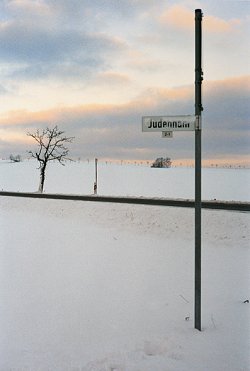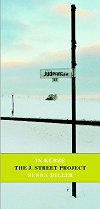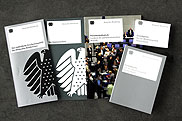Navigationpath: Startseite > Kultur & Geschichte > Kunst im Bundestag > Kunstausstellungen > "The J. Street Project" von Susan Hiller
Susan Hiller: "The J. Street Project"

Susan Hiller: Jüdenhain in: The J. Street Project © S. Hiller, Courtesy: Galerie Volker Diehl Berlin, Timothy Taylor Gallery London
15 October 2008 to 11 January 2009
Susan Hiller's series The J. Street Project examines the German-Jewish past in a unique and highly moving manner. In 2007, the German Bundestag's Art Council acquired three works from this series for Parliament's art collection, namely the Snow Scenes / Schneeszenen (2003). Now the entire project is going on display as a whole.
The artist embarked upon the project in 2002, while undertaking a residency in Berlin sponsored by the German Academic Exchange Service (DAAD). She chanced upon a street named "Jüdenstraße" - "Jews' Street" - and her surprise and confusion led her to research whether there were similar street names elsewhere in Germany. Her search uncovered 303 street names which still contained the word "Jude" - "Jew". Susan Hiller's three-year journey of discovery through Germany resulted in over 300 photographs, a list of places and streets with a map of Germany, a video installation and a lengthy book. Her remembrance work with The J. Street Project reveals the vestiges of a past that in many places has vanished almost without trace, and in this way highlights the painful loss of a once rich Jewish culture in Germany and its constant endangerment through misinterpretation, resentment and exclusion. Susan Hiller's photographs, which also show the surrounding town, village or landscape, take the viewer on a journey that is only seemingly nostalgic, off the beaten tourist track, right across Germany. They are disquieting travel photos, as the former inhabitants of these streets and places are gone, having fallen victim to unfathomable crimes - from the anti-Jewish pogroms of the Middle Ages to the Holocaust. It is painful to view the deceptive tranquillity of these unremarkable places and landscapes, which seem united in a quiet, muted lament for the dead. Some of the photographs call to mind the expanses of Caspar David Friedrich's landscapes, their loneliness and melancholy. When, in the Snow Scenes, the snow makes the signs almost unreadable, it is almost impossible to suppress thoughts of death, transience and oblivion, the failed hope of the "dream of reason". Looking at the setting sun over the silent expanse of the field "Am Judenfriedhof", the now overgrown "Judenstraße", the forest solitude of the "Judenbuckelweg", the motorway over the "Judenchaussee" or the Jewish grave marker "Am Judenstein" - a relic of the anti-Jewish pogroms of the 16th century - thoughtlessly surrounded by traffic signs, one senses that with each photo, Susan Hiller opens up wide-ranging scope for us to reflect and make associations, shows the ever new and ever different ways of dealing with these vestiges of the Jewish past in Germany, and makes tangible the interface between past and present. She directs our attention to the signs all around us of a past which we should keep alive and of which we should be more aware.
A similar mood of remembrance, leave-taking and loss runs through many of the works produced by Susan Hiller, one of the most important British conceptual artists. She combines anthropology and culture in both her work and her studies. In April 2008, as part of the 5th Berlin Biennial for Contemporary Art, she displayed an installation entitled The Last Silent Movie. A television emitted the sound of voices speaking in extinct languages, but the screen remained dark, so that the speakers - the last of their language and culture - remained literally in the dark, the dark obscurity of history. In her works, Susan Hiller wrestles with "ghosts of the past" (S.H.), examines the inexplicable (Wild Talents, 1997, Psi Girls, 1999), the realm of hallucinations (Witness, 2000) and dreams (Dream Screens, 1996). But her starting point is always her observations of reality and, from these fragments, she creates art which questions the world.
Place of exhibition
Art Room of the German Bundestag
15 October 2008 to 11 January 2009
Marie-Elisabeth Lüders Building, Schiffbauerdamm, 10117 Berlin
Entrance on the Spree Promenade, on the opposite bank to the Reichstag Building
Opening hours
Tuesday to Sunday from 11 to 17 hrs
Susan Hiller
Born in 1940 in Tallahassee, Florida
Lives and works in London
Information
Tel.: +49 (0)30 227-32027
kunst-raum@bundestag.de
www.kunst-im-bundestag.de
Published by: German Bundestag
Secretariat of the Art Council
Platz der Republik 1, 11011 Berlin
Text and concept: Andreas Kaernbach, Curator of the German Bundestag's Art Collection
With assistance from: Kristina Volke
Further information
Further Information
Information Material
-
Flyer: "The J. Street Project" by Susan Hiller
-
Information material in different languages



